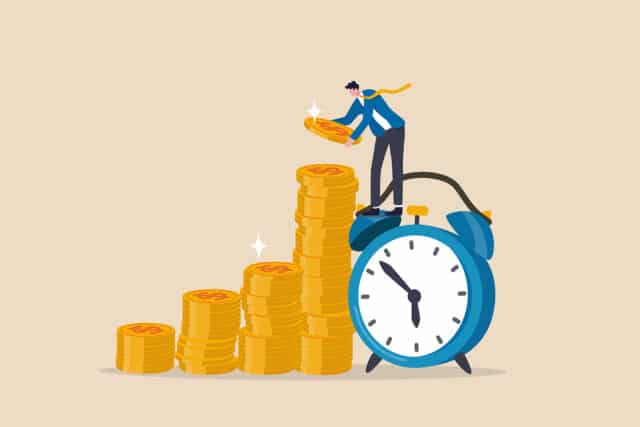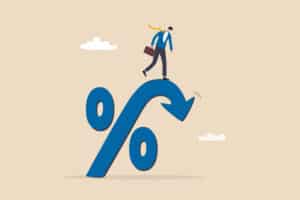As Federal Reserve interest rate cuts ripple through the financial system, Massachusetts banks are having to rethink their strategies for a key deposit-gathering tool – high-yield certificates of deposit.
The Fed cut its benchmark short-term rate by 50 basis points in September, the first cut since early 2020. During this time, savings products such as certificate of deposits were able to raise rates as well.
According to Bankrate data, the top interest rates for six-month, one-year, three-year and five-year CDs have fallen by between 20 and 120 basis points over the last 11 months. After beginning 2020 at 0.76 percent, the average interest rate of a one-year CD stands at 1.9 percent in October of 2024.
Prior to the Fed’s 11 inflation-fighting rate increases, CDs weren’t a large part of bank portfolios, said Erik Porter, CFO at the Cooperative Bank of Cape Cod. That changed once rates began to climb in 2022 and customers moved their built-up savings from core accounts to savings products such as CDs earning higher rates.
While rates are on the decline, they are still relatively high compared to where they were during the pandemic.
“The rates that we’re able to offer for high-yield, money markets, and CDs are still very compelling,” said Angela Conti, senior vice president and head of consumer and small business banking at Cambridge Savings Bank. “If a customer doesn’t need immediate access to their money, they feel comfortable putting it into a certificate of deposit for a few months or even a year, that could be a very good investment for them.”
Savings Accounts Could Replace CDs
But as CDs become less attractive, observers say, banks will face a challenge retaining deposits. Some are already rolling out new products in response.
Liberty Bank has introduced a sign-on bonus and executives there said banks could offer other perks to customers signing up for new accounts.
Even subscriptions to streaming services could serve as a potential bonus banks can offer to customers opening new accounts, said Liberty CFO Paul Young. High-yield savings accounts could also grow in popularity as customers have access to their funds while receiving a higher annual percentage yield.
Liberty Bank recently introduced a high yield savings account where customers can earn an above-market yield and a 0.50 percent APY bonus rate if they have an active “Pay Back” or “Quarterback” checking account with Liberty Bank.
“Most banks will reduce rates on CD and savings products; some will cut rates quicker than others based on their liquidity position and level of concern about deposit attrition,” Young said. “Liberty’s relationship high-yield savings [product] was launched with the cuts in mind, but also to provide customers with rate certainty through the end of 2024.”

Since the Federal Reserve’s inflation-busting rate campaign, banks have used high-yield certificates of deposit to successfully and quickly gather deposits. iStock illustration
Looking to Delay the Inevitable
But rate cuts from the Fed don’t always equate to rate cuts on savings products. For example, The Cooperative Bank of Cape Cod did not cut rates on its CDs after the most recent cuts from the Fed.
Liquidity needs play a factor in financial institutions’ decision-making when shifting rates, but can also let them delay the inevitable decision to reduce CD interest rates as the Fed continues its campaign of cuts.
“Maybe we might keep our rates elevated longer than an institution down the road, because our liquidity is stronger,” Porter said. “Or vice versa, we might not have as much loan volume, we might have customers who are waiting on the sidelines because they think rates are going to drop another 100 basis points, so they want to wait until the spring.”
When looking to shift rates, Cambridge Savings looks to see if there are alternative funding options that can absorb the Fed’s rate changes.
“Especially as a community mutual, where we give back to our community, we want to offer competitive rates to our customers and we evaluate that full equation,” Conti said. “Anytime we can fund loans through deposits, is a good day for us, because that is the business that we’re in, and that’s where we’re fulfilling customer needs on both sides.”
So far, Cambridge Savings has been able to keep rates at its digital arm shrinking slower than the Fed’s 50-basis-point rate cut, with positive results.
Conti said that the Cambridge Savings Bank portfolio for consumer and small business deposits remains stable. And Cambridge’s digital bank arm, Ivy Bank, shifted the high-yield savings rate it offers from 5.3 percent to 5 percent APY but balances have increased 5 percent since the shift three weeks ago.
“I think it’s really about making sure that we are cognizant of what’s going on in the environment and that we’re thoughtful about making prudent decisions,” she said. “Because we certainly can’t pay more to a customer for a deposit than we would charge for a loan. We need those economics to work out, but we want to remain salient and really top of mind for the services that we provide to our customers.”
With the Fed’s interest rate-setting board scheduled to meet this week, bankers will get another indication of whether interest rates are headed lower.
If they are, rates won’t be the only way to attract and retain customers, a bank can’t ignore competitive rates, Porter said.
“Ultimately, we need to do an effective job of communicating the value that we provide to our customer base over and above the rate environment,” he said. “But beyond that, specific to [interest] rate, we have to ensure that we don’t ignore competitive pricing or other product offerings, so that we make sure that we provide the community and our customers opportunities for growing their deposits and ensuring that those deposits are safe with us.”






